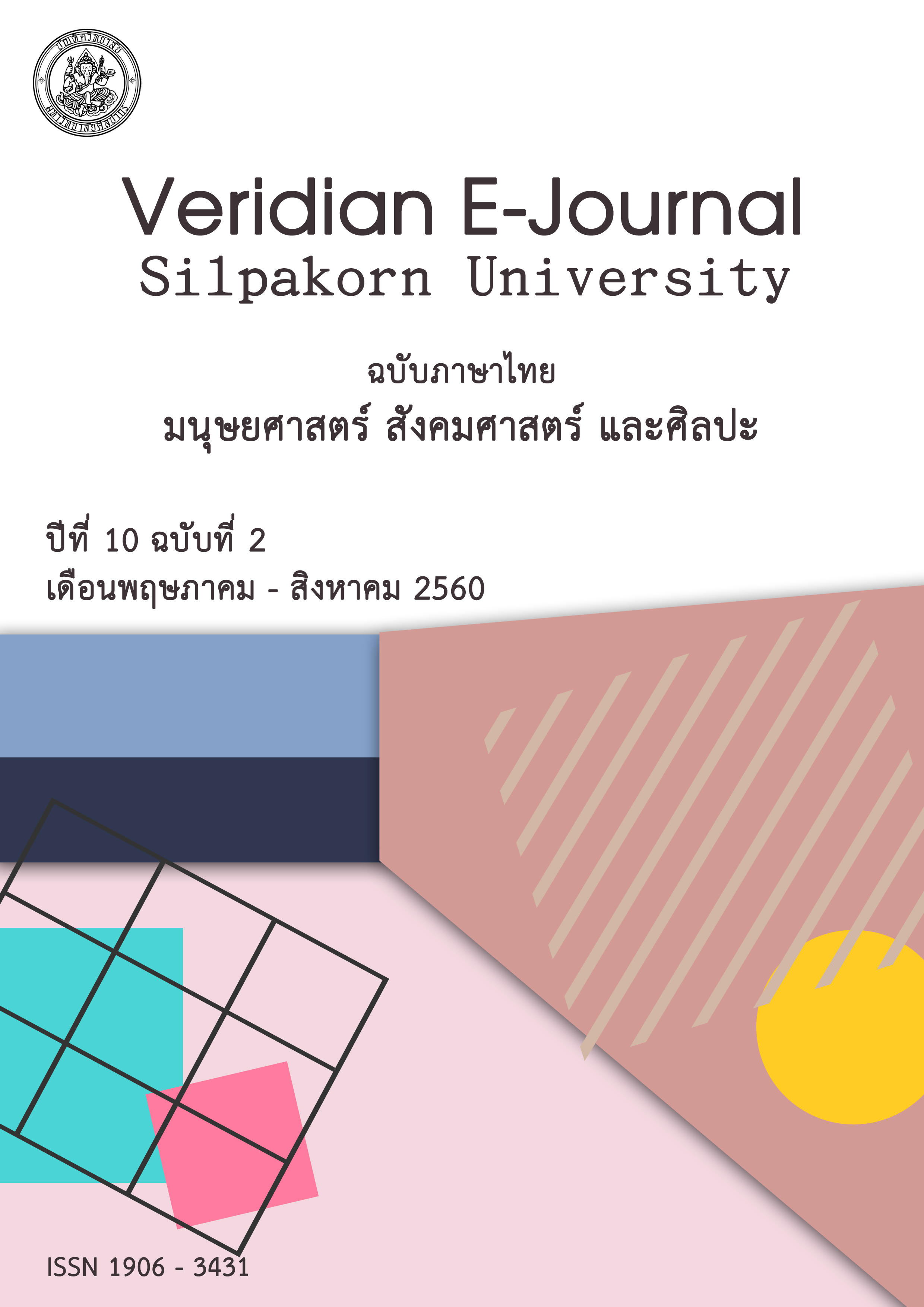ยุทธศาสตร์การจัดการลุ่มน้ำวังแบบมีส่วนร่วมของชุมชน
Main Article Content
Abstract
การวิจัยนี้มีวัตถุประสงค์เพื่อวิเคราะห์กระบวนการจัดการลุ่มน้ำวัง ระดับการมีส่วนร่วม และปัญหา อุปสรรคของการมีส่วนร่วมของประชาชนในการจัดการลุ่มน้ำวัง และวิเคราะห์ปัจจัยที่ส่งผลต่อความสำเร็จของการมีส่วนร่วมของประชาชนในการ ในการจัดการลุ่มน้ำวัง รวมทั้งเสนอแนวทางและยุทธศาสตร์การจัดการลุ่มน้ำวังแบบมีส่วนร่วมของชุมชน ซึ่งผลจากการวิจัยจะก่อให้เกิดประโยชน์ ทั้งทางด้านวิชาการ ด้านนโยบาย ด้านสังคมและชุมชน และด้านการจัดการทรัพยากรธรรมชาติและสิ่งแวดล้อมรวมทั้งประโยชน์ด้านการศึกษาวิจัยและพัฒนาหลายประการ ซึ่งจะนำไปสู่การพัฒนาการจัดการทรัพยากรธรรมชาติและสิ่งแวดล้อมการจัดการลุ่มน้ำที่มีความเหมาะสม และสอดคล้องกับพื้นที่ ใช้วิธีวิจัยเชิงคุณภาพ ประชากรเป้าหมาย และผู้ให้ข้อมูลสำคัญ ประกอบด้วยผู้บริหาร บุคลากรภาครัฐที่รับผิดชอบ ผู้เชี่ยวชาญ นักวิชาการ คณะกรรมการอนุกรรมการจัดการลุ่มน้ำวัง ผู้นำชุมชน ปราชญ์ชาวบ้าน และประชาชนในพื้นที่ เครื่องมือที่ใช้ในการเก็บรวบรวมข้อมูล คือ แบบสำรวจ แบบสอบถาม แบบสัมภาษณ์ และการจัดประชุมกลุ่ม ประชุมเชิงปฏิบัติการ และจัดประชุมวิพากษ์ การวิเคราะห์ และตรวจสอบความถูกต้องของข้อมูล โดยเน้นการมีส่วนร่วมของทุกฝ่าย วิเคราะห์เนื้อหาและนำเสนอข้อมูลทั้งเชิงคุณภาพและข้อมูลเชิงปริมาณ
การวิจัยในครั้งนี้ ได้ดำเนินงานครบถ้วนทุกขั้นตอนตามกรอบคิดที่นำเสนอไว้ในระเบียบวิธีวิจัยและได้นำผลจากการศึกษามาวิเคราะห์ สังเคราะห์โดยได้ผลสรุปดังนี้ การดำเนินงานของการจัดการลุ่มน้ำวัง ทั้งในส่วนต้นน้ำ กลางน้ำ และปลายน้ำมีรูปแบบใกล้เคียงกัน สามารถแบ่งรูปแบบการดำเนินงานของการจัดการลุ่มน้ำวังออกเป็น 4 รูปแบบสำคัญ คือ 1) รูปแบบการจัดการโดยรัฐ 2) การจัดการโดยหน่วยงานภาคเอกชน หรือ องค์กรพัฒนาเอกชน (NGOs) 3) การจัดการโดยชุมชน 4) การจัดการตามแนวทางการดำเนินงานของ “โครงการอันเนื่องมาจากพระราชดำริ”ศักยภาพความพร้อมและ ปัญหา อุปสรรค ในการจัดการลุ่มน้ำวัง จากการศึกษาพบว่าการจัดการลุ่มน้ำวังทั้ง 4 รูปแบบมีศักยภาพความพร้อมของการจัดการลุ่มน้ำวังในหลายด้านประกอบด้วย ศักยภาพและความพร้อมทางด้านทรัพยากรสนับสนุนของภาครัฐ การมีหน่วยงานกลางประสานเชื่อมโยงพื้นที่ภายในลุ่มน้ำทั้งระบบ ความเข้มแข็ง และวิสัยทัศน์ของผู้นำชุมชน ภูมิปัญญาและองค์ความรู้ท้องถิ่น และความรู้สึกเป็นเจ้าของทรัพยากรร่วมของชุมชน และขณะเดียวกันก็มีปัญหาอุปสรรคในการการจัดการลุ่มน้ำวังในหลายด้านเช่นกัน อาทิ การจัดการแบบแยกส่วนของภาครัฐ การจัดการที่ขาดองค์ความรู้ และส่งเสริมองค์ความรู้ การจัดการของภาครัฐที่ขาดการเปิดโอกาสให้ชุมชนมีส่วนร่วมและการเข้าถึงสภาพปัญหาอย่างแท้จริง การจัดการของภาครัฐที่ขาดการรับรู้และการนำไปปฏิบัติ การจัดการที่ขาดการรับรู้และการนำไปปฏิบัติตามแนวทางสะท้อน ที่เป็นจริงจากชุมชน การจัดการของภาครัฐในลักษณะ Top – down ขาดความต่อเนื่องในการดำเนินงานผู้นำชุมชนขาดวิสัยทัศน์ ความมุ่งมั่นและความเข้มแข็งในการดำเนินงาน
การวิจัยในครั้งนี้ได้ดำเนินงานครบถ้วนทุกขั้นตอนตามกรอบคิดที่นำเสนอไว้ในระเบียบวิธีวิจัยและได้นำผลจากการศึกษามาวิเคราะห์ สังเคราะห์โดยได้ผลสรุปซึ่งสามารถอธิบายในรูปของ KHOMKHWAN Model โดยมีรายละเอียดประกอบด้วย 1) K = Knowledge Management Dimensions สร้างความรู้ความเข้าใจโดยการจัดการความรู้ในทุกมิติ 2) H = Human Resource Development and Leadership Motive Building สร้างคนและผู้นำในการขับเคลื่อน 3) O = Organizing for Collaborative Management จัดทำโครงสร้างการจัดการร่วมกัน กฎ กติกา และธรรมนูญชุมชน 4) M = Management for Creative Practice การจัดการเพื่อนำไปสู่การปฏิบัติ และการดำเนินงานในรูปแบบต่าง ๆ 5) K = Knowledge Sharing from Operational Experiences จัดการความรู้รอบที่ 2 ข้อมูลย้อนกลับ สร้างการยอมรับ เห็นประโยชน์ร่วมกัน 6) H = Homeland Natural Resource Awareness พัฒนาสมาชิกในชุมชน สร้างกระบวนการเรียนรู้ร่วมกัน และสร้างความรู้สึกการเป็นเจ้าของในทรัพยากรธรรมชาติร่วมกันของคนในชุมชน 7) W = Wisdom Integrated Locally and Modernly การบูรณาการภูมิปัญญาท้องถิ่นกับการจัดการสมัยใหม่ เพื่อพัฒนากระบวนการจัดการที่เหมาะสมกับบริบทพื้นที่ นำไปสู่การสร้างต้นแบบการจัดการและขยายต่อแนวคิด 8) A = Authentic Activities Continuously กิจกรรมที่มีอย่างต่อเนื่อง ยึดโยงการอนุรักษ์กับความเชื่อของชุมชน และฐานภูมิของแผ่นดิน สื่อสาร สร้างจิตสำนึกอย่างต่อเนื่อง 9) N = Networks for Community Integrated Management สร้างเครือข่าย และชุมชนต้นแบบในการจัดการลุ่มน้ำแบบมีส่วนร่วมของชุมชน
This research aimed to analyze the processing management for Wang basin, the level of public participation as well as the problems and obstacles in Wang basin management and to analyze factors that affected the success of public participation in basin management, including the approaches and strategies with the community’s participation. This study is qualitative research. The research result will be beneficial in academic, policy planning, society and community including natural resource and environmental management especially in Wang basin area. This study adopted qualitative research which targets to population and key respondents composing of executive,governmental officer, expert, academician,sub-committee of Wang basin management, head of community, local savant and local people in the area. Collecting data by survey, questionnaire, interview, focus group, workshop, critical meeting collaboratively, and the data was analyzed and presented both in qualitative and quantitative ways according to the research objectives.
The results of the study of Wang basin management in the past showed the similarity among upstream, middle stream and downstream of management process. Four patterns of process for Wang basin management were classified as follows: 1) government management process 2) private sector or NGO management process 3) community management process and 4) management process based on the operational guidelines; "Royal Project"In terms of potential and availability, including problems and obstacles in Wang basin management, the results of the study showed that the four patterns of Wang basin management had the potential of readiness in aspect of the strength and vision of community leaders, folk wisdom and local knowledge as well as the sense of belonging for community resources and the availability of central organization linking the whole area within the basin, including the government’s assistance regarding the resources. Besides, there were problems in the management of the Wang basin in many aspects such as the problem of fragmentation regarding government’s management, lack of knowledge management, lack of public management to engage the community and access to problematic conditions, lack of awareness and implementation, lack of awareness of reflective practices based on the community, and the problem of Top-down management, lack of operational continuity , vision, commitment as well as strength of the community’s leader.
In the aspects of strategies in the basin management with the community participation, this research had conducted every step to present the strategies easily and comprehendible The researchers described the strategies in terms of KHOMKHWAN Model that composed of eight strategies as follows: 1) K = Knowledge Management Dimensions 2) H = Human Resource Development and Leadership motive Building 3) O = Organizing for collaborative management 4) M = Management for creative practice 5) K = Knowledge Sharing from operational experiences 6) H = Homeland Natural Resource Awareness 7) W = Wisdom integrated locally and modernly 8) A = Authentic Continuity of Activities 9) N = Networks for Community Integrated Management
